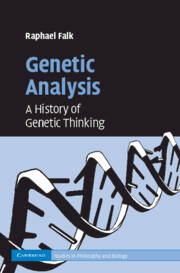Book contents
- Frontmatter
- Contents
- List of figures
- Acknowledgments
- Introduction
- PART I FROM REPRODUCTION AND GENERATION TO HEREDITY
- PART II FAKTOREN IN SEARCH OF MEANING
- PART III THE CHROMOSOME THEORY OF INHERITANCE
- PART IV GENES AS THE ATOMS OF HEREDITY
- PART V INCREASING RESOLVING POWER
- PART VI DEDUCING GENES FROM TRAITS, INDUCING TRAITS FROM GENES
- PART VII WHAT IS TRUE FOR E. COLI IS NOT TRUE FOR THE ELEPHANT
- Concluding comments
- Bibliography
- Index
PART VI - DEDUCING GENES FROM TRAITS, INDUCING TRAITS FROM GENES
Published online by Cambridge University Press: 07 August 2009
- Frontmatter
- Contents
- List of figures
- Acknowledgments
- Introduction
- PART I FROM REPRODUCTION AND GENERATION TO HEREDITY
- PART II FAKTOREN IN SEARCH OF MEANING
- PART III THE CHROMOSOME THEORY OF INHERITANCE
- PART IV GENES AS THE ATOMS OF HEREDITY
- PART V INCREASING RESOLVING POWER
- PART VI DEDUCING GENES FROM TRAITS, INDUCING TRAITS FROM GENES
- PART VII WHAT IS TRUE FOR E. COLI IS NOT TRUE FOR THE ELEPHANT
- Concluding comments
- Bibliography
- Index
Summary
Mendel's decision to select such unit characters that would provide insight into the laws of hereditary transmission, whatever their physiological or developmental properties may be, was crucial in the establishment of genetics as an independent discipline of inheritance (Falk, 1995). But when de Vries in 1900 recognized Mendel's work it was because he believed it to contribute to his hypothesis of Intracelluläre Pangenesis, a bottom-up determinist theory of organisms' development and function, as part of the strategic goal of his Die Entstehung der Arten durch Mutation. Indeed, the “unit character” was as much a notion of development as one of inheritance. As conceived by Bateson, unit characters were defined by properties that segregate according to Mendelian rules, and he tried to explicate their role in the physiology and development of the organisms accordingly (see Chapter 3).
Thus, from its inauguration the discipline of genetic research was burdened or blessed with the dialectic tension between the methodological reductionism of hybridists, deducing genes from traits, and the conceptual determinism of morphogenists, inducing traits from genes.
Although geneticists never lost interest in problems of physiology and development (Gilbert, 1998), they did adopt, as a rule, a bottom-up perspective of individual traits rather than a top-down perspective of organisms in their context. However, they needed some empirical handle to examine speculations such as the Weismann–de Vries hypothesis of specific nuclear particles being differentially exported to the cytoplasm of somatic cells.
- Type
- Chapter
- Information
- Genetic AnalysisA History of Genetic Thinking, pp. 209 - 210Publisher: Cambridge University PressPrint publication year: 2009



